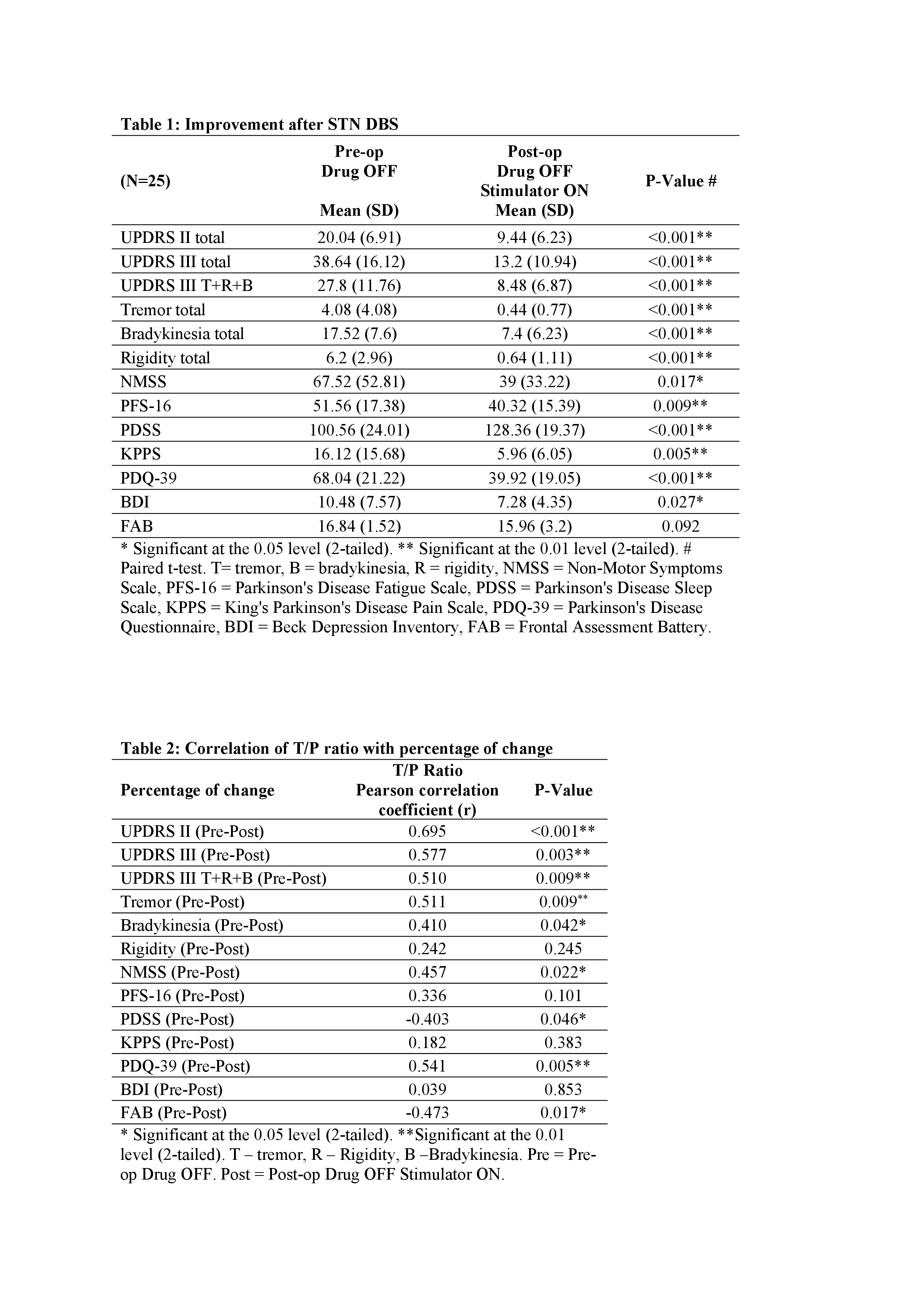Objective: To test the predictive value of predominance of tremor versus PIGD scores on the motor and non-motor outcomes of bilateral STN DBS for Parkinson’s disease (PD).
Background: Levodopa-responsiveness of the motor signs of PD measured by the UPDRS III score, is a well-established predictor of the motor outcome of PD following STN DBS. Though the cardinal signs of PD improve consistently after surgery, postural instability, freezing and gait improve to variable degrees. Poor outcomes in these signs reduce the overall improvement in quality of life of patients. The predominance of these signs, if assessed before surgery, may help in predicting the motor, non-motor and quality of life outcomes of STN DBS.
Method: Patients with PD and motor fluctuations or dyskinesias who qualified for bilateral STN DBS, were prospectively recruited. Pre-(ON and OFF) and post-operative assessments (STIM ON with drug OFF) were done using standard rating scales. Scores of UPDRS, NMSS, PDQ39, Frontal Assessment battery, Depression, Fatigue, Pain scales and sleep scales for PD were collected pre and post-surgery. Improvement at 6 months after surgery was measured as percentage of change in scores between Pre-OP, DRUG OFF and STIM ON, Drug OFF states. Tremor score was measured as the mean of UPDRS II item 16 + UPDRS III items 20 and 21. PIGD score was measured as mean of UPDRS II items 13 (falls), 14 (freezing), and 15 (walking) + UPDRS III items 29 (gait), and 30 (postural stability).1 Pre-op ratio of tremor and PIGD scores (T/P)1 in OFF was converted to continuous variable as reported.2 Pearson’s correlation was used to test association.
Results: 25 patients completed the study. Improvement was seen in UPDRS II, III, PDQ-39, NMSS, Fatigue, sleep and pain scores (Table 1). T/P ratio had positive correlations with improvements in UPDRS II (P<0.01, r=0.7), UPDRS III (P<0.01, r = 0.6), NMSS (P < 0.05, r =0.5) and PDQ-39 (P<0.01 r=0.5) and negative correlations with PD sleep score (P<0.05, r= -0.4) and frontal assessment battery scores (Table 2).
Conclusion: Pre-operative assessment in Drug OFF state of the relative predominance of tremor versus PIGD scores can be a useful predictor of overall changes in severity of motor and non-motor symptoms, activities of daily living and quality of life after STN-DBS.
References: 1. Stebbins GT, Goetz CG, Burn DJ, Jankovic J, Khoo TK, Tilley BC. How to identify tremor dominant and postural instability/gait difficulty groups with the movement disorder society unified Parkinson’s disease rating scale: comparison with the unified Parkinson’s disease rating scale. Mov Disord. 2013;28(5):668-70.
2. Isabel Alfradique-Dunham, Rami Al-Ouran, Rainer von Coelln, et al. Genome-Wide Association Study Meta-Analysis for Parkinson Disease Motor Subtype
Neurol Genet. 2021; 7(2): e557.
To cite this abstract in AMA style:
C. Nagireddy, K. Pillai, S. Joshua, A. Pnair, D. Panikar, M. Chacko, A. Kishore. Pre-operative predominance of Tremor versus PIGD scores in drug OFF state predicts motor and non-motor outcomes of STN-DBS for Parkinson’s disease [abstract]. Mov Disord. 2023; 38 (suppl 1). https://www.mdsabstracts.org/abstract/pre-operative-predominance-of-tremor-versus-pigd-scores-in-drug-off-state-predicts-motor-and-non-motor-outcomes-of-stn-dbs-for-parkinsons-disease/. Accessed December 17, 2025.« Back to 2023 International Congress
MDS Abstracts - https://www.mdsabstracts.org/abstract/pre-operative-predominance-of-tremor-versus-pigd-scores-in-drug-off-state-predicts-motor-and-non-motor-outcomes-of-stn-dbs-for-parkinsons-disease/

